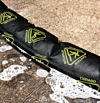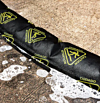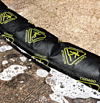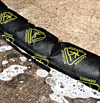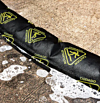
In environments where both workplace hazards and physical demands create dual challenges, the integrity of protective workwear depends significantly on construction quality—particularly at critical seam junctions. While the protective materials themselves receive considerable attention, seam failure represents one of the most common compromise points in otherwise effective safety garments. This comprehensive review examines how Fristads protective workwear with reinforced seams, available through Hall-Fast, delivers exceptional protection integrity even under extreme workplace conditions, ensuring safety barriers remain intact despite the physical stresses of demanding professional applications.
Understanding the Critical Role of Seam Integrity
Before examining specific solutions, it's essential to understand why seams represent both vulnerability points and critical protection zones in protective clothing:
Structural Vulnerability Factors: Several characteristics make seams particularly susceptible to failure:
- Inherent structural interruption where continuous material protection is broken
- Concentrated stress points where different fabric directions meet and tension focuses
- Potential ingress pathways for hazardous substances if seam integrity fails
- Higher mechanical strain during movement as seams frequently align with flex points
- Reduced material thickness at needle penetration points creating potential weakness
Safety-Critical Functions: Despite these vulnerabilities, seams serve essential protective roles:
- Joining different protective materials to create comprehensive hazard barriers
- Forming three-dimensional shapes that provide full-body protection coverage
- Creating reinforced zones where multiple material layers provide enhanced protection
- Enabling articulated construction that maintains protection during movement
- Forming sealed barriers against liquid or particulate penetration in chemical protection
Common Seam Failure Modes: Understanding typical seam breakdown helps address vulnerabilities:
- Thread breakage under tension when movement exceeds thread strength
- Fabric tear adjacent to stitching where needle penetration weakens material
- Seam slippage where stitching remains intact but fabric shifts within thread loops
- Seam leakage where microscopic gaps between stitches allow hazardous penetration
- Binding separation where edge finishing detaches from main protective materials
Performance Consequences: Seam failure creates serious protection compromises:
- Complete protection breach allowing direct hazard contact with skin or underlying clothing
- Reduced protection lifetime as failures progress from minor to catastrophic
- Unpredictable protection gaps that may not be immediately visible to wearers
- Integrity compromise during critical situations when protection is most essential
- Cascading failure where initial small compromises rapidly expand under continued stress
Advanced Seam Technologies in Protective Workwear
The foundation of exceptional seam performance in protective clothing involves specialized construction techniques:
Reinforced Stitch Engineering: Beyond basic seam construction, protective garments require enhanced approaches:
- Triple-needle construction that maintains integrity even if individual threads fail, providing redundant protection against seam separation
- Specialized stitch patterns that distribute mechanical stress across broader areas rather than concentrating force at individual thread points
- Bartack reinforcement at all critical stress points using heavy-duty thread and high-density stitching to withstand extreme tension
- Engineered stitch length and tension optimization that balances strength with maintained material integrity
Specialized Thread Selection: The connecting element itself significantly impacts protection performance:
- Para-aramid threads like Kevlar® that provide exceptional tensile strength up to 5-8 times stronger than standard polyester thread
- Chemical-resistant thread formulations matched to specific garment protection types, ensuring maintained integrity despite hazardous substance exposure
- Flame-resistant thread varieties that maintain seam integrity during thermal exposure in FR garments
- UV-stabilized thread types that prevent solar degradation in outdoor protective applications
- Specialized core-spun constructions that combine strength fibres with protective outer sheaths
Advanced Seam Construction Methods: The architecture of seam formation creates significant performance differences:
- Bound seam technologies that fully encase raw edges to prevent unravelling under stress while adding reinforcement layers
- Flat-felled constructions that eliminate exposed edges while providing quadruple material layers at seam junctions
- Welded seam integration for liquid-proof barriers that eliminate needle penetration points entirely
- Safety stitch combinations that provide both structural strength and edge finishing in unified constructions
- Reinforced overlap designs that maintain protection continuity even during extreme stretching
Strategic Reinforcement Systems: Anticipating stress patterns allows preventative strengthening:
- Additional material layers applied to high-stress seams that distribute force across broader areas
- Reinforcement tapes bonded along seam lines to prevent separation under tension
- Strategic bartack placement based on movement analysis and stress mapping
- Graduated reinforcement that provides maximum strength at peak stress points while maintaining flexibility in articulation zones
- Bias-cut reinforcement strips that provide multi-directional strength at complex seam junctions
Material Integration for Enhanced Seam Performance
The interaction between materials and seam construction significantly impacts protection integrity:
Compatible Material Selection: Effective seam reinforcement begins with appropriate material pairing:
- Matched extensibility characteristics that prevent differential movement stress at seam junctions
- Compatible chemical resistance properties ensuring all components maintain protection against the same hazards
- Thermal behaviour alignment that prevents differential shrinkage or melting during heat exposure
- Abrasion resistance consistency that maintains balanced wear patterns across seam junctions
- Thickness compatibility that allows proper needle penetration and thread formation without compromising material integrity
Edge Treatment Technologies: Material preparation before seaming significantly impacts durability:
- Heat-sealed edges that prevent fraying and material degradation at cut points
- Ultrasonic cutting that fusion-seals synthetic material edges during the cutting process
- Specialized binding applications that encapsulate raw edges before main seam construction
- Chemical edge stabilization for natural fibres that prevents progressive unravelling
- Reinforced edge preparation that strengthens material before needle penetration
Interface Engineering: The transition zone between different materials requires specialized approaches:
- Graduated interface construction that eliminates abrupt transitions that could create stress concentration
- Specialized interlining materials that provide additional structure at material junctions
- Bonded interface zones that create unified materials before stitching to reduce seam stress
- Overlapped protection layers that maintain hazard barriers across material transitions
- Material orientation optimization that aligns strongest directions across seam junctions
Reinforcement Material Selection: Additional components at seams provide specialized enhancement:
- High-tensile reinforcement tapes with break strength exceeding the main protective materials
- Chemical-resistant binding compatible with the primary protection certification
- Fire-retardant seam reinforcement for thermal protection garments
- Waterproof seam sealing for liquid-proof protective clothing
- Abrasion-resistant overlay materials at high-wear seam locations
Strategic Seam Placement for Protection Optimization
Beyond construction techniques, the location and orientation of seams significantly impact protection integrity:
Protection-Optimized Pattern Engineering: Advanced design approaches minimize vulnerability:
- Reduced seam quantity through innovative pattern cutting that eliminates unnecessary junctions
- Strategic seam placement away from high-exposure areas in hazard-specific garments
- Anatomical mapping that positions seams to align with natural body contours rather than against them
- Movement analysis integration that prevents seam placement at maximum flex points
- Hazard mapping that eliminates seams in primary exposure zones for specific applications
Stress Distribution Architecture: Well-designed seam placement prevents concentrated force:
- Curved rather than straight seam paths that distribute stress across broader areas
- Articulated construction that incorporates movement allowance without seam strain
- Strategic gusset placement that provides additional material at flex points
- Graduated seam angles that prevent direct tension alignment with primary force directions
- Panel size optimization that balances material efficiency with minimized seam requirements
Activity-Specific Seam Engineering: Different work activities create unique stress patterns:
- Reaching movement accommodation through specialized shoulder and arm seam placement
- Bending and kneeling optimization through articulated waist and knee seam design
- Climbing and stretching allowance through strategic seam positioning at extension points
- Twisting movement accommodation through spiral rather than vertical seam paths
- Tool-carrying reinforcement where equipment weight creates additional seam stress
Industry-Specific Placement Optimization: Different sectors create unique seam stress patterns:
- Construction focus with reinforcement at points contacting building materials and equipment
- Manufacturing emphasis on repetitive movement zones where consistent actions create predictable stress
- Maintenance specialization addressing confined space movement and equipment contact points
- Agriculture and forestry orientation with emphasis on varied body positions during outdoor work
Performance Testing for Seam Integrity Verification
Ensuring reinforced seams deliver reliable protection requires specialized evaluation methods:
Mechanical Performance Testing: Physical stress resistance verification includes:
- Tensile strength testing where seams are subjected to direct pulling forces until failure
- Burst testing evaluating multi-directional pressure resistance at seam junctions
- Abrasion resistance assessment measuring wear resistance at seam locations
- Flex testing subjecting seams to repeated bending to simulate workplace movement
- Impact testing evaluating seam integrity when subjected to sudden force application
Protection-Specific Seam Evaluation: Beyond physical performance, protection continuity requires verification:
- Liquid penetration testing for chemical protective clothing seams
- Thermal exposure assessment for flame-resistant garment seams
- Particulate barrier evaluation for dust-protective clothing seams
- Weathering resistance for outdoor protective workwear seams
- Electrical continuity testing for anti-static protective clothing seams
Real-World Simulation Testing: Laboratory evaluation is complemented by practical assessment:
- Movement-based testing where garments undergo simulated workplace activities
- Extended wear trials evaluating seam performance through repeated use cycles
- Environmental exposure testing subjecting seams to relevant workplace conditions
- Combined stress evaluation incorporating multiple simultaneous forces on seam systems
- Accelerated aging protocols that predict long-term seam performance
Certification-Specific Seam Requirements: Formal protection standards often include specialized seam criteria:
- Type 3 chemical protection requiring sealed seams tested to specific pressure resistance
- Flame-resistant seam construction tested separately from main material performance
- High-visibility garment requirements for seam placement relative to reflective elements
- Biological protection standards with specific seam barrier performance testing
- Weather protection with specialized seam waterproofness evaluation
Industry-Specific Applications for Reinforced Seam Protection
Different sectors benefit from specialized seam reinforcement relevant to their unique demands:
Chemical and Process Industries: These environments combine chemical exposure with physical movement:
- Sealed seam technologies that prevent liquid chemical penetration at construction points
- Chemical-resistant thread selection matched to specific workplace substances
- Reinforced construction at high-flex points commonly used during process operations
- Multiple protection layers at critical junctions where both movement and exposure coincide
The Chemical Defender Series exemplifies these features with additional elements including ultrasonic welded seams in primary exposure zones, triple-layer bound construction in secondary areas, and specialized thread selection tested against industry-specific chemicals.
Construction and Heavy Engineering: These physically demanding environments create extreme seam stress:
- Impact-resistant reinforcement at shoulder and knee seam junctions that experience equipment contact
- Heavy-duty thread selection with tensile properties appropriate for building material weight
- Articulated seam design that accommodates climbing, kneeling, and reaching without strain
- Abrasion-reinforced seam overlays that withstand contact with rough building materials
The Construction Pro Series features these capabilities with additional elements including specialized bartack placement based on construction movement analysis, reinforced tool pocket attachment seams, and extended overlap construction at primary stress points.
Maintenance and Repair Operations: These varied applications require adaptable protection:
- Multi-directional reinforcement at seams accommodating complex positioning during repair tasks
- Chemical-resistant construction for environments with exposure to maintenance fluids
- Specialized stretching allowance at seams for confined space access requirements
- Tool-carrying reinforcement where pocket seams support equipment weight
The Maintenance Pro Series demonstrates these capabilities with features including spiral seam paths that distribute stretching forces, reinforced pocket construction designed for tool organization, and articulated protection zones with seam placement optimized for repair positioning.
Outdoor and Utility Work: These applications combine environmental exposure with physical demands:
- Weather-sealed seams that prevent water ingress during outdoor operations
- UV-resistant thread selection that maintains integrity despite solar exposure
- Temperature-adaptive construction that accommodates both cold-weather layering and summer heat
- Visibility-optimized seam placement that works with high-visibility elements
The Outdoor Utility Series offers these features with additional elements including fully-taped seam construction for waterproof integrity, reinforced climbing zones for pole and elevated work, and specialized thread selection with documented UV resistance testing.
Maintenance Considerations for Maximal Seam Performance
Preserving seam integrity throughout the protective garment's service life requires appropriate care:
Industrial Laundering Compatibility: Professional cleaning processes create specific challenges:
- Heat-stabilized constructions that withstand industrial temperature washing without shrinkage stress
- Reinforced attachment points that resist mechanical action during industrial cleaning processes
- Chemical-resistant thread and bindings compatible with industrial detergent formulations
- Structural design that prevents tunnel washer distortion at critical seam junctions
Repair Accessibility: Maintaining protection may require occasional seam restoration:
- Clearly identified critical seams where professional repair is required to maintain certification
- User documentation specifying appropriate repair methods for different seam types
- Accessible construction that allows effective repair without compromising protection
- Modular design allowing component replacement rather than complete garment retirement
Inspection Protocols: Regular assessment helps identify issues before failure:
- Visual inspection guidelines for early identification of thread deterioration or stitching compromise
- Specific tension testing procedures for critical seam evaluation
- Established replacement indicators based on objective seam condition assessment
- Documentation systems tracking seam performance throughout garment lifecycle
Storage and Handling Guidance: Between use periods, appropriate care prevents degradation:
- Proper folding techniques that prevent unnecessary seam stress during storage
- Hanging recommendations that distribute garment weight without seam strain
- Environmental controls that prevent moisture or temperature damage to seam components
- Handling procedures that minimize unnecessary stress during transport and distribution
Finding Your Ideal Reinforced Seam Protection
At Hall-Fast, we understand that selecting appropriate protective workwear with reinforced seams involves matching specific protection requirements with durability needs for your particular working environment. Our comprehensive collection of Fristads protective workwear includes options with advanced seam technology engineered for reliable performance in demanding conditions.
Browse our complete Fristads-Kansas workwear collection at Hall-Fast.com to explore our range of protective garments with reinforced seam construction. Our detailed product descriptions include specific seam technology information, making it easy to identify garments with construction appropriate for your workplace requirements.
Need expert advice on selecting optimal protective workwear with reinforced seams for your specific industry or application? Our knowledgeable team can provide guidance on appropriate construction types and seam technologies based on real-world performance in similar conditions. Simply email sales@hall-fast.com with details of your working environment and protection requirements, and we'll help you find the perfect Fristads protective solution with seam reinforcement engineered for your specific needs.
Choose Fristads protective workwear with reinforced seams from Hall-Fast for the optimal combination of certified protection, exceptional durability at critical construction points, and practical functionality—ensuring your safety garments maintain their protective integrity even in the most demanding working environments.



